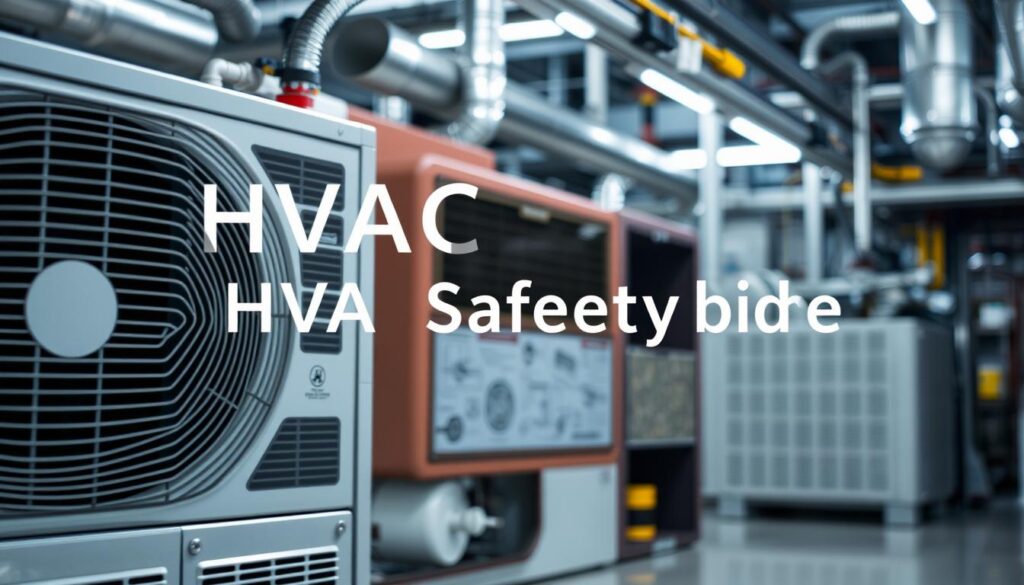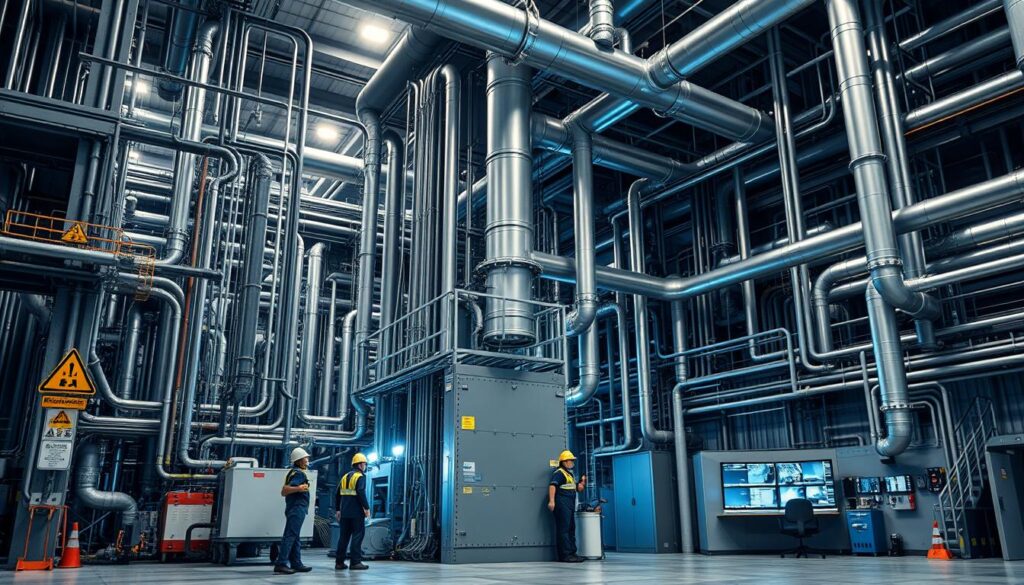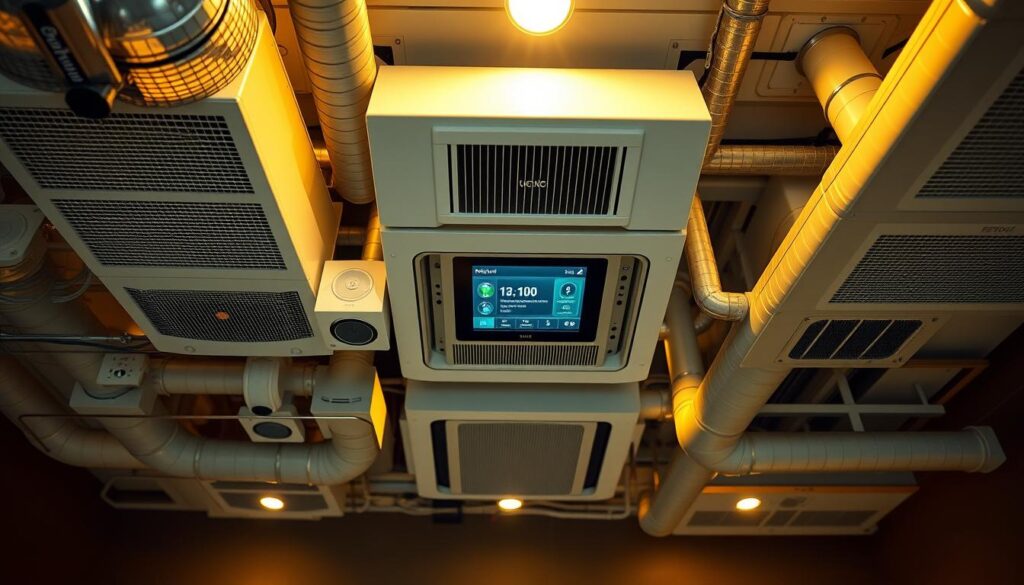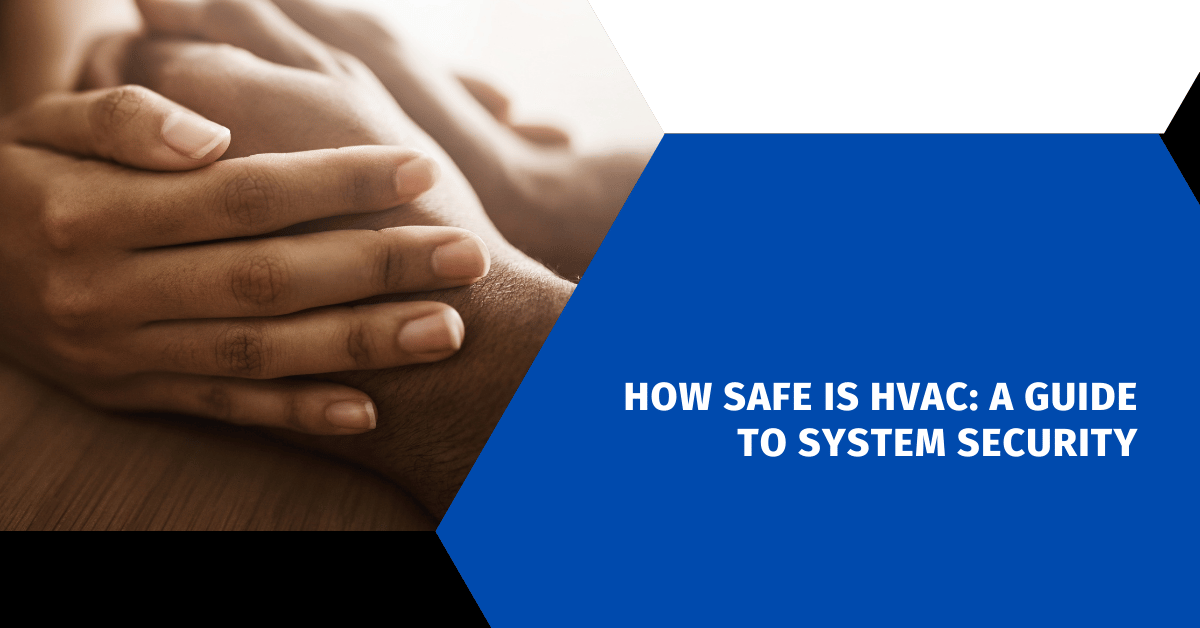Affiliate Disclosure
HVAC Guide Guys is a participant in the Amazon Services LLC Associates Program, an affiliate advertising program designed to provide a means for sites to earn advertising fees by advertising and linking to Amazon.
How Safe Is HVAC? Would you trust a system that could potentially compromise your building’s safety and comfort? HVAC systems are more than just temperature control devices. They are complex networks that need strict safety protocols and detailed security measures.

Understanding how safe is HVAC means seeing the challenges of modern heating, ventilation, and air conditioning systems. There are electrical risks and cybersecurity threats. HVAC safety measures are key to protecting both the equipment and the people inside.
Professional technicians and building managers must focus on safety strategies that cover many possible risks. This guide will look at important ways to keep HVAC systems safe and reliable in homes, businesses, and factories.
Key Takeaways
- HVAC safety requires multi-dimensional risk management
- Professional training is key for system security
- Regular maintenance stops possible dangers
- Cybersecurity is a growing worry in HVAC systems
- Comprehensive safety plans protect both equipment and people
Table of Contents
Understanding HVAC Security Fundamentals
HVAC systems are key to keeping buildings safe and comfortable. They do more than just control the temperature. They also have safety features and technology to prevent dangers.
Modern buildings use advanced HVAC systems. These systems have many layers of protection. They must handle complex security challenges while working well.
Key Components of HVAC Safety
Good HVAC safety includes several important parts:
- Comprehensive risk assessment
- Regular system inspections
- Following strict hvac regulations
- Using advanced monitoring technologies
“Safety in HVAC is not an option—it’s a fundamental requirement for protecting human health and infrastructure integrity.”
Modern Security Challenges in HVAC Systems
Today, HVAC systems face big security threats. They can be hacked, leading to data breaches and other problems.
Impact of System Security on Building Operations
Strong HVAC security is vital for a building’s success. It ensures:
- Energy efficiency
- Comfort and safety for occupants
- Smooth facility management
- Following industry standards
Proactive security strategies turn HVAC systems into smart, responsive solutions for building management.
Essential Personal Protective Equipment for HVAC Work
Working in HVAC systems requires careful protection. The right personal protective equipment (PPE) is key to avoiding hazards. Professional technicians know that proper gear prevents injuries and health risks.
Your PPE toolkit should have several important items. These are designed to keep you safe during HVAC work:
- Steel-toed work boots for foot protection against heavy equipment drops
- Full-coverage clothing to prevent cuts and chemical exposures
- Thick HVAC work gloves with enhanced grip and protection
- Hard hat to protect against overhead impacts
- Safety goggles and face shields for eye and facial protection
- Respirator masks for filtering harmful airborne particles
- Hearing protection like earplugs during loud system operations
Different HVAC environments need specific protective gear. For example, electrical work needs insulated gloves. Refrigerant handling requires chemical-resistant equipment. Knowing your job’s needs helps you choose the right safety measures.
Quality PPE is more than just following rules—it’s about protecting yourself. Regularly check and replace worn-out gear to stay safe during HVAC work.
Explore Our HVAC Shop
Looking for top-rated HVAC tools, parts, and accessories? Visit our shop and find the perfect solution for your needs.
Visit the ShopCommon HVAC Safety Hazards and Prevention
Working in HVAC systems comes with many hazards. It’s important to know these risks to stay safe. HVAC workers need to follow strict safety rules to protect themselves and their work area.
Staying safe in HVAC work means knowing and avoiding risks. The main hazards fall into three main categories:
- Electrical risks
- Chemical exposure dangers
- Respiratory protection challenges
Electrical Safety Protocols
Electrical systems are a big danger in HVAC work. To stay safe, follow these key steps:
- Always disconnect power before working on equipment
- Use proper lockout/tagout procedures
- Wear the right personal protective equipment
- Check circuit isolation with professional tools
Chemical Exposure Risks
HVAC systems use chemicals that can harm your health. It’s important to handle refrigerants and cleaning agents carefully to avoid accidents or injuries.
| Chemical Type | Potential Risk | Safety Recommendation |
|---|---|---|
| Refrigerants | Respiratory irritation | Use respirator and work in ventilated areas |
| Cleaning Agents | Skin and eye exposure | Wear protective gloves and safety glasses |
Respiratory Protection Measures
Keeping your respiratory system safe is key in HVAC work. Dirty environments can cause serious health problems. Choose the right respirator for your job and make sure it fits well and is maintained.
“Safety is not an accident, but a deliberate and consistent practice in HVAC professional work.” – HVAC Safety Institute
How Safe Is HVAC: Current Industry Standards

Knowing about hvac regulations is key to keeping heating, ventilation, and air conditioning systems safe and working well. Professional groups are vital in setting up detailed safety rules. These rules protect workers and people living or working in buildings.
Important groups that help set hvac safety standards include:
- American Society of Heating, Refrigerating and Air-Conditioning Engineers (ASHRAE)
- Occupational Safety and Health Administration (OSHA)
- Environmental Protection Agency (EPA)
These groups work together to create strict safety rules for HVAC systems. Their standards cover important areas like:
- How to install equipment
- Maintenance steps
- Testing system performance
- Guidelines for protecting workers
“Safety isn’t expensive, it’s priceless” – Anonymous HVAC Professional
These standards are updated often to keep up with new tech and safety issues. Following these rules helps professionals reduce risks and improve system performance.
It’s important for anyone in HVAC to know the latest standards. Knowing the rules is the first step in keeping systems safe.
Explore Our HVAC Shop
Looking for top-rated HVAC tools, parts, and accessories? Visit our shop and find the perfect solution for your needs.
Visit the ShopCybersecurity Threats to HVAC Systems
Modern HVAC systems are now complex, not just simple temperature controllers. They are connected to networks, which brings big cybersecurity challenges. To keep buildings safe and data secure, strong hvac safety measures are needed.
Cyber threats can harm entire building networks. They can create openings for hackers. Your digital safety depends on your weakest link, and HVAC systems are often a big risk.
Network Vulnerabilities in HVAC Systems
Potential network weaknesses in HVAC systems include:
- Unsecured wireless connections
- Outdated software and firmware
- Weak authentication protocols
- Unencrypted communication channels
Data Protection Strategies
To keep HVAC systems safe, a multi-layered cybersecurity approach is needed. Important steps include:
- Regular software updates
- Strong password management
- Network segmentation
- Advanced encryption techniques
Building Automation System Security
Keeping building automation systems safe requires active security steps. Continuous monitoring, thorough risk assessments, and training employees are key to a secure HVAC setup.
By tackling cybersecurity risks, you can protect your HVAC systems. This ensures they work well and stay safe from threats.
Environmental Safety Considerations
Your HVAC system is key to keeping the air inside your home clean. It also helps with protecting the environment. Knowing how your heating and cooling system affects the planet helps you make better choices.
HVAC emissions are a big problem for our planet. Today’s systems are working hard to cut down on carbon footprints. They use new tech and green practices to do this.
- Refrigerant selection impacts global warming
- Energy-efficient designs cut down on carbon emissions
- Advanced filtration makes the air inside your home cleaner
Companies are creating eco-friendly HVAC options. These options are good for the planet and keep the air inside your home clean. They help lower harmful emissions while keeping the air quality high.
| Environmental Factor | Impact Level | Mitigation Strategy |
|---|---|---|
| Refrigerant Emissions | High | Low-GWP Refrigerants |
| Energy Consumption | Medium | High-Efficiency Systems |
| Air Filtration | Low | HEPA Filter Technology |
Learning about these environmental factors can really help. By focusing on clean air and choosing green HVAC options, you help the planet. You’re part of a bigger effort to make our world more sustainable.
Sustainable HVAC practices protect both your indoor environment and the planet’s ecosystem.
Explore Our HVAC Shop
Looking for top-rated HVAC tools, parts, and accessories? Visit our shop and find the perfect solution for your needs.
Visit the ShopProfessional Certification and Training Requirements
HVAC certification is key for professionals wanting to show their skills in the heating, ventilation, and air conditioning field. It helps you grow in your career and keep up with new tech.
Understanding HVAC certification involves knowing its different parts. It includes education, tests, and ongoing learning.
Required Licenses and Certifications
States have their own rules for HVAC workers. You’ll need to:
- EPA Section 608 Certification
- State-specific HVAC licensing
- Complete a technical training program
- Pass recognized exams
Ongoing Education and Updates
Keeping up with industry standards is vital for HVAC certification. Professional development helps you:
- Learn about new technologies
- Know updated safety rules
- Stay technically skilled
- Keep your credentials current
Safety Training Programs
Comprehensive safety training is a must for HVAC certification. It covers:
| Training Area | Key Focus |
|---|---|
| Electrical Safety | Preventing workplace accidents |
| Equipment Handling | Proper use of specialized tools |
| Environmental Regulations | Following federal guidelines |
By always learning and keeping your HVAC certification, you show you’re dedicated to being the best in your field.
Indoor Air Quality and Ventilation Safety

Your indoor environment is key to your health and comfort. HVAC systems keep the air safe and clean. It’s important to know how your building’s air quality and ventilation work together.
Keeping your HVAC system in good shape is vital for the air you breathe. Dust, allergens, and harmful particles can build up in your system. This can be harmful to your health. Regular checks and professional cleanings are musts for clean air.
- Replace air filters every 3-6 months
- Schedule professional HVAC inspections annually
- Monitor humidity levels between 30-50%
- Use high-efficiency particulate air (HEPA) filters
New air purification technologies are changing how we manage indoor air. Ultraviolet germicidal irradiation and advanced filters can kill tiny pollutants. This adds extra protection to your home or office.
Clean air is not a luxury, but a fundamental requirement for healthy indoor environments.
Improving your HVAC system’s performance is an investment in your health. By understanding how HVAC and air quality are connected, you can make your spaces safer and more breathable. This supports your overall well-being.
Explore Our HVAC Shop
Looking for top-rated HVAC tools, parts, and accessories? Visit our shop and find the perfect solution for your needs.
Visit the ShopEmergency Response and Safety Protocols
Keeping your HVAC system and workplace safe is key. Unexpected problems can get worse fast without a plan. So, it’s important to have safety steps ready to avoid big issues.
Creating a plan for HVAC safety is essential. It’s all about being quick to respond to emergencies. This helps reduce damage and keeps people safe.
- Identify possible emergency situations
- Set up clear ways to communicate
- Train staff on how to act fast
- Make sure everyone knows how to leave quickly
Important steps for HVAC emergencies include:
| Emergency Type | Immediate Action | Safety Priority |
|---|---|---|
| Refrigerant Leak | Evacuate area, ventilate space | Respiratory protection |
| Electrical Failure | Disconnect power source | Prevent electrical hazards |
| Carbon Monoxide Detection | Immediate building evacuation | Life-threatening risk |
Regular drills and training are vital for HVAC safety. Your team should check safety plans often and update them as needed.
Linking HVAC safety plans with overall building safety is smart. Being ready ahead of time can lower risks and protect everyone and everything.
Maintenance and Regular Safety Inspections
Keeping your HVAC system safe and working well needs a proactive plan. Regular maintenance is key to keeping your system reliable, efficient, and safe.
Good hvac inspections do more than just check things off a list. They look at how well your system works, its structure, and any safety risks.
Preventive Maintenance Schedules
Having a solid preventive maintenance plan helps you:
- Spot problems before they start
- Lower the chance of sudden breakdowns
- Make your HVAC system last longer
- Avoid expensive emergency fixes
“Prevention is always more cost-effective than reactive repairs.” – HVAC Industry Expert
Safety Audit Procedures
Thorough safety audits should check:
- Electrical parts and connections
- Refrigerant levels and leaks
- How well the mechanical parts are set up
- How well the air moves and is cleaned
Documentation Requirements
Keeping detailed records of your hvac maintenance is very important. Your records should show how your system is doing, any fixes, and when you last checked it. This keeps your system safe and in line with rules.
Remember: A well-documented HVAC system is a safer, more reliable system.
Conclusion
Knowing how safe HVAC systems are involves a detailed approach. It starts with understanding how technology, the environment, and people affect HVAC safety. This knowledge is key to keeping systems running well and securely.
HVAC safety is an ongoing effort. It requires regular upkeep, training, and the latest security steps. Every part of HVAC safety, from cyber threats to safety gear, needs careful focus and ongoing learning.
Experts and building managers are vital in keeping HVAC systems safe. They must stay updated, follow rules, and use the latest safety tools. This helps lower risks and keeps systems working at their best in homes and businesses.
Your effort to learn about HVAC safety protects more than just equipment. It also keeps people healthy and safe. A complete safety plan that includes new tech, training, and risk management makes HVAC systems safe and efficient.

